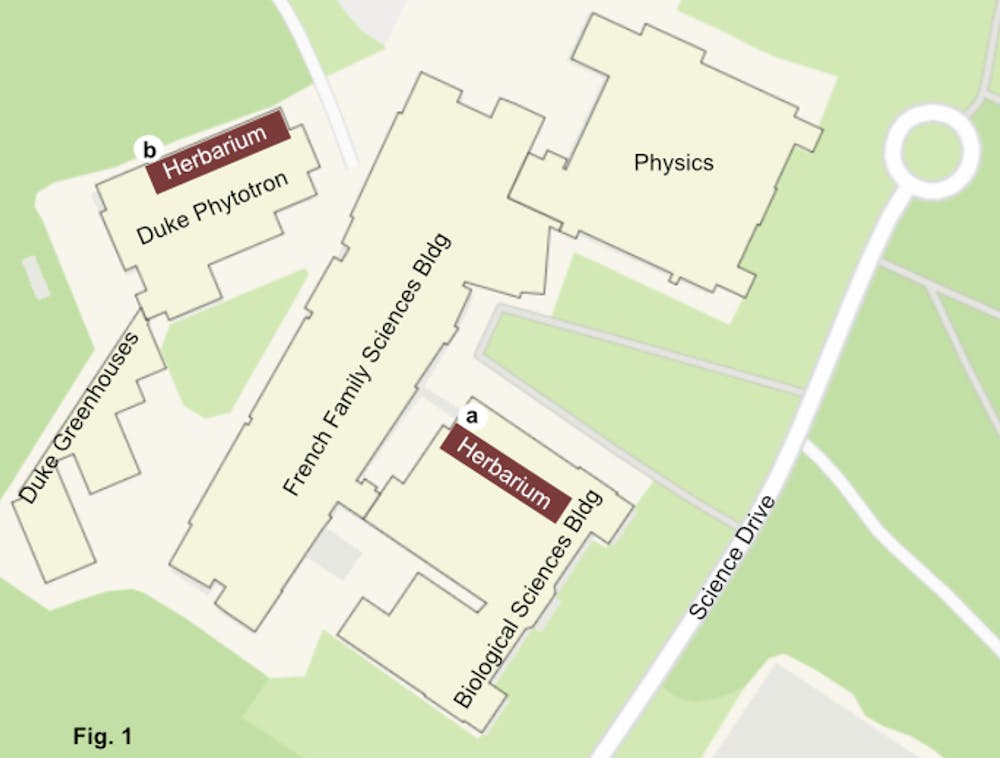When you think of a library at Duke, you may think of the rows and rows of bookshelves in Perkins, or maybe the intriguing displays in the David M. Rubenstein Rare Book and Manuscript Library.
But look past these traditional libraries and you'll find a brimming “library” of plants called the Duke Herbarium.
Housing just under one million pressed, dried and labeled plant specimens, the Duke Herbarium is tied with Cornell’s as the sixth-largest university herbarium in the United States, according to Kathleen Pryer, director of the Duke Herbarium and professor of biology. It acquired its specimens over time primarily through research-directed field collections by Duke faculty, staff and students and by gift and exchange with other herbaria around the world.
However, Pryer said that people are often disappointed when they realize a herbarium is not an herb garden with live plants.
“If you go to the [Duke Greenhouse], you're like, wow, these little plants!” Pryer said. “You go to the herbarium, and it's tons of steel cabinets.”
But these cabinets may contain a data gold mine for climate research as Duke tries to unite education, research, operations and public service missions within the Duke Climate Commitment. The Herbarium is also making its data more accessible worldwide through its ongoing efforts to digitize its specimen collections.
“We're really talking about the world of biological collections, and the future of what they hold for a new brand of scientists who are interested in the data,” said Paul Manos, professor in the biology department and associate curator of vascular plants at the Herbarium.
A walk through the Herbarium
Duke’s earliest herbarium began when Hugo L. Blomquist arrived at Trinity College in 1921 with a collection of specimens stored in shoe boxes. Today, the herbarium consists of its original space in the Biological Sciences building, and its newer space in the Phytotron. It houses collections of vascular plants, bryophytes, algae, lichens and fungi, the oldest of which are around 200 years old, according to Pryer.
The Biological Sciences space is dimly lit with tightly packed cabinets that contain rows of neatly stacked folders. In total, this space houses 400,000 cryptogamic specimens, all of which are “organized in a very specific fashion,” Pryer said.

Pryer pulled out a red folder — meaning that the specimen was collected in North Carolina — and opened it to reveal dried Southern maidenhair ferns pressed onto a thick sheet of paper.
“And there you have a specimen collected by Frank Smith, May 13, 1934 in Columbia County,” she said. “North end of Lake Waccamaw.”
She then pointed to a much larger fern collected from Fiji.
“[Herbaria] all share material and send material, so this may have been collected by somebody who went to Fiji to study something else, collected this and brought this back,” she said.

Every week, the Herbarium interacts with researchers from many countries — Australia, Russia, Mexico and Brazil, to name a few — to request to borrow specimens for research.
Manos also mentioned that he is part of a joint project funded by the National Science Foundation to study the evolution of blueberry species. He’s worked with the Botanical Research Institute of Texas to collect over 400 plants across the range of all species for their analyses.
Continuing the tour, Pryer and Manos entered the Herbarium’s supply room. From floor to ceiling, the room was filled with material for specimen collection, which included blotting papers, cardboard, folders and bubble wrap.
Pryer explained that specimens are pressed in newspaper before they are placed on blotting sheets to squeeze all the water out of them, which can take two to three days. Specimens that are collected in the tropics need to be put in alcohol.
“Everybody's got their press that they're fond of,” Pryer said. “I still have my original plant press that I checked out from the McGill Herbarium as an undergraduate to make my first collections in the field.”
Digitization and the future of Duke Herbarium
By the mid-1970s, the number of specimens started to outgrow its space in the Biological Sciences building, and cabinets began lining the hallways and stairwells.
In order to accommodate a growing collection, in 2009, the new Phytotron Herbarium opened adjacent to Biological Sciences. It provides compact mobile storage space for about 425,000 flowering plant specimens on one floor, which are organized from the “most primitive to the most specialized,” according to Manos. The Phytotron is also noticeably cooler and dryer, which helps preserve the plants and keeps pests from eating them.
In the Phytotron, Pryer opened a folder containing a dried pink lady’s slipper specimen, a hint of color still lingering on its petals. A barcode was pasted on one corner of the paper, indicating that this specimen had been scanned and uploaded onto a database. It’s evidence of the Herbarium’s efforts to digitize its collections, which began more than two decades ago.

Today, the Herbarium is a member of the Southeast Regional Network of Expertise and Collections, a National Science Foundation-funded partnership between 233 herbaria across the southeastern United States that aim to digitize four million specimens. To date, Duke Herbarium has contributed 142,596 images of specimens, including all of its lichen and algae collections.
Manos said that the Herbarium now functions as a global resource.
“It used to be that countries that couldn't really confidently ask for a loan, because they might not have had the facilities to get a loan from a museum,” Manos said. “There's a broader, more inclusive group of scientists that are part of this world now.”
Although digitization has broken grounds by allowing “virtual borrowing,” Pryer and Manos still expressed concerns for the Herbarium’s future.
“I remember a day not so long ago when we started getting these digitization grants, [Duke] basically said, ‘That’s fantastic: now we can throw them away and make space,’” Pryer said.
“We can get DNA out of these," she continued. "These aren't books that you have one copy [of] or you have a photocopy of.”
Manos is worried that he’s seen a decline in accommodations for plant science and plant diversity in recent years. He mentioned how larger herbaria like the Smithsonian Botanical Garden’s have “swallowed up” collections as schools have begun abandoning their own.
“Some of it is always accompanied with some level of sadness about when a school decides that it's going to change gears or that it can no longer house these particular things,” he said.
In September, however, Duke announced its new Climate Commitment, which aims to address four focus areas: energy transformation, climate and community resilience, environmental and climate justice and data-driven climate solutions.
With this new initiative, Pryer and Manos are hopeful that the Duke Herbarium will be seen as an integral link for climate research.
“Something’s afoot to appreciate these data and scientists are writing papers for global biology and global change. And it’s based on these specimens,” Pryer said.
Pryer studies how plant-insect associations may have shifted during the Anthropocene in response to pollution, habitat loss and invasive species, and the dried plants in the herbarium serve as a data source for this study. The early stages of her research required examining actual physical specimens under a microscope, but that proved to be a very slow process.
“When we realized that we could try to apply machine learning techniques to the high-res images, we began to collaborate with computer scientists on campus to train computers to identify these signatures on the actual images,” Pryer wrote in an email to The Chronicle.
For Pryer and Manos, the sky is the limit when digital and physical specimens are combined with machine learning and artificial intelligence.
“Who knows, 20 years from now [we] will certainly be applying novel approaches that we have not even thought of yet to tap into these specimen resources for the secrets they hold,” Pryer wrote.
Ultimately, Pryer and Manos hope that the Herbarium will be around for generations of Duke students and researchers to come. They are currently working on a strategic plan that advocates for the Herbarium to be recognized as a critical resource at Duke.
“For us stewards of this legacy, we're going to do whatever we can … to ensure this resource is properly managed going forward,” Manos said.
Get The Chronicle straight to your inbox
Signup for our weekly newsletter. Cancel at any time.

Katie Tan is a Trinity senior and digital strategy director of The Chronicle's 119th volume. She was previously managing editor for Volume 118.

Senou Kounouho is a Pratt sophomore and a university news editor of The Chronicle's 119th volume.

